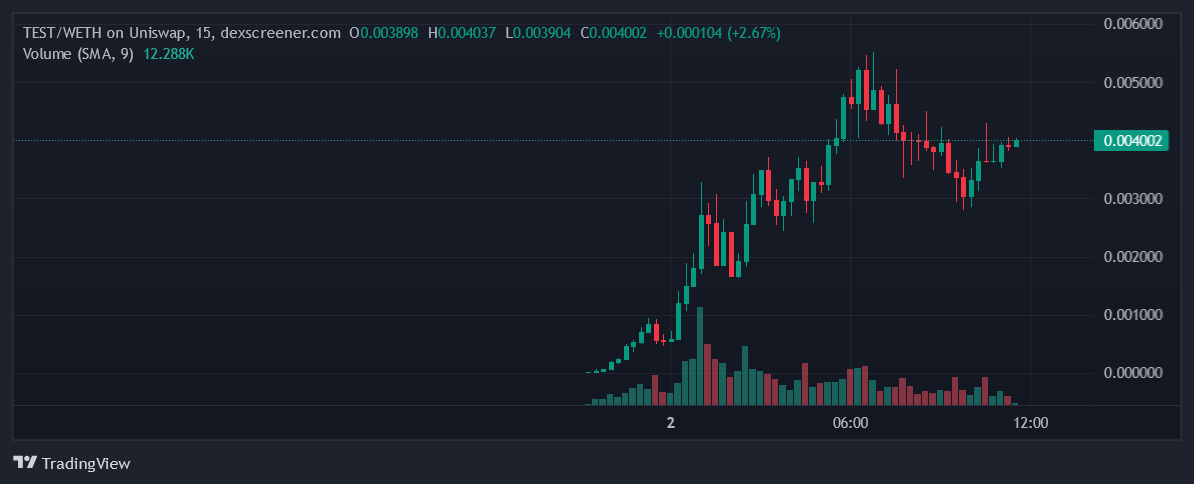Accidental Genius?- How A 4CHAN Developer Inadvertently Created A Century-Locked TEST Crypto Token!
0
0
Introduction: A Happy Mishap
When we think about breakthroughs in technology, we often imagine meticulous planning, sophisticated algorithms, and extensive testing. However, in the fast-paced and sometimes chaotic world of blockchain and cryptocurrencies, innovation can come from the most unexpected quarters. In an amusing turn of events, a 4CHAN developer accidentally created a crypto-token with a locked liquidity period exceeding 100 years! This developer, now recognized for the ‘$TEST’ token mishap, has stirred up the world of decentralized finance. Let’s take a look at this TEST crypto token article in detail.
The $TEST Crypto Token: A Century-Long Commitment. What does this mean?
Traditionally, when liquidity is locked in DeFi projects, the lockup period ranges from a few months to several years. This timeframe provides some security to investors, ensuring that developers cannot simply drain the liquidity pool on a whim. However, our 4CHAN developer, in a comedic twist of fate, exceeded these conventional timeframes by locking the liquidity of the $TEST token for more than a century!
The accidental locking of liquidity for such an extended period has resulted in a bizarre yet intriguing scenario. Due to this “lockup error,” the $TEST token holders are left with a unique and unusual type of crypto investment, essentially trapped in a century-long commitment.
A “Century-Locked Crypto-Token” is a term that refers to a specific type of cryptocurrency, or “crypto-token,” whose liquidity is locked for a hundred years.
Let’s break down this concept a little further:
- Crypto-Token: A crypto-token is a type of virtual currency that resides on a blockchain and represents a value or a utility. For example, you might have heard of Bitcoin or Ethereum, which are types of crypto-tokens.
- Liquidity: In the context of cryptocurrencies, liquidity usually refers to the ease with which a crypto-token can be bought or sold without affecting the token’s price. When liquidity is high, transactions don’t significantly impact the token’s price; when liquidity is low, transactions can cause significant price changes.
- Liquidity Lock: When developers launch a new crypto-token, they usually pool some tokens and pair them with a more stable currency like Ethereum or USDT. This pool provides liquidity, making it possible for users to trade the new token. Locking this liquidity means the initial pool of tokens and paired currency cannot be removed for a specified period. This measure is usually taken to build trust with investors, ensuring that the developers or initial holders cannot suddenly sell all their tokens (a move called a ‘rug pull’), causing the token price to crash.
A “Century-Locked Crypto-Token” means that a developer has locked the liquidity of a crypto-token for a hundred years. This is unusually long, as most liquidity lock periods range from a few months to a few years. It’s like saying, “We’ve created this digital currency, and to show you we won’t suddenly sell all our tokens and cause the price to crash, we promise not to touch the initial pool of tokens for a hundred years.” It’s a significant commitment that offers a high degree of security to token holders but also requires a long-term investment.
Developer Mishap or Market Marvel?

This unprecedented event has left the crypto community speculating: Is this a disastrous developer oversight or an accidental stroke of genius? On one hand, the locked liquidity provides extreme assurance to investors that the token cannot be rug-pulled. On the other hand, this assurance comes at the cost of a massive time commitment. It has raised an important question – Can a cryptocurrency sustain its value and investor interest for a century?
The concept of having liquidity locked for a century, as seen with the $TEST token, is a novel occurrence in the world of cryptocurrencies. In simpler terms, this means that the original pool of tokens, which ensures the stability and security of the token’s value, cannot be touched or sold off for a hundred years. It’s like a digital treasure chest that cannot be opened until a century has passed. This unusual scenario creates an investment that’s not just for you, but potentially for your grandkids as well. Essentially, by investing in such a token, you’re planting a financial seed for your future generations, who will be the ones to reap the benefits when the liquidity lock finally ends.
The Community Reaction on Test Crypto Token: Laughter and Speculation
The reaction to this unusual event on 4CHAN and other social media platforms has been a mix of amusement, disbelief, and speculative curiosity. The initial laughter resulting from the “lmfao” tagline given by the developer has now transitioned into a larger discussion about the token’s future.
Despite the humor, some investors see this as a golden opportunity. The token’s locked liquidity ensures a level of security unmatched by many other cryptocurrencies, and they are keen to see if this inadvertent experiment could result in a long-term investment strategy. Meanwhile, critics argue that the lack of liquidity flexibility could make the token unappealing for those wanting a quicker return on their investments.
The $TEST token, despite its unconventional inception, has surpassed expectations by doing more trading volume than most tokens on the Ethereum Mainnet today. This unexpected success highlights the intrigue and speculative interest it has generated in the crypto community. The token’s locked liquidity for a century, while initially seen as a comedic mishap, appears to have sparked significant interest among crypto enthusiasts.
The high trading volume suggests that many are willing to invest in such a long-term commitment, perhaps drawn to the extreme security it offers against rug pulls. It is a testament to the unpredictable and dynamic nature of the cryptocurrency market, where an accident can turn into an asset. This unexpected turn of events has the potential to reshape traditional perspectives on liquidity lock periods in DeFi, compelling market participants to rethink their strategies and risk tolerance.
What Does This Mean For The Future of DeFi?
The $TEST token incident, though born out of an error, has highlighted the experimental nature of DeFi and the unexpected paths it can take. It has drawn attention to the importance of liquidity lockups in bolstering investor trust and raised questions about optimal lockup periods.
While a century-long liquidity lock might seem excessive, it is prompting a reevaluation of traditional DeFi strategies. As the $TEST token story unfolds, it may provide valuable lessons for developers and investors alike.
Conclusion: The Accidental Revolution
In a world dominated by meticulous planning and careful execution, the $TEST token has brought forth the idea that accidents, too, can bring about change. This unprecedented 100-year liquidity lock might have been a mishap, but it has created an unusual opportunity for those daring enough to take the long view. Whether the $TEST token becomes a symbol of security or a reminder of inflexibility remains to be seen, but one thing is for sure – it has certainly left an indelible mark on the world of crypto.
0
0
 Manage all your crypto, NFT and DeFi from one place
Manage all your crypto, NFT and DeFi from one placeSecurely connect the portfolio you’re using to start.




